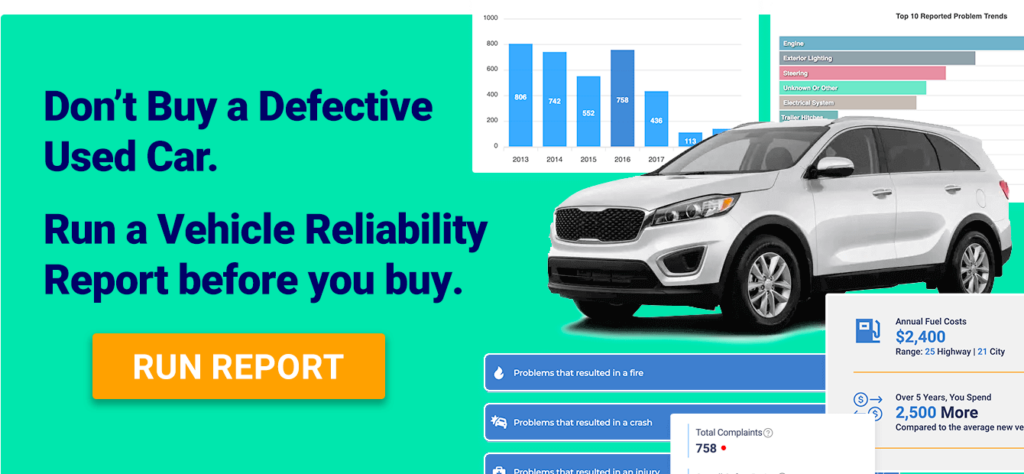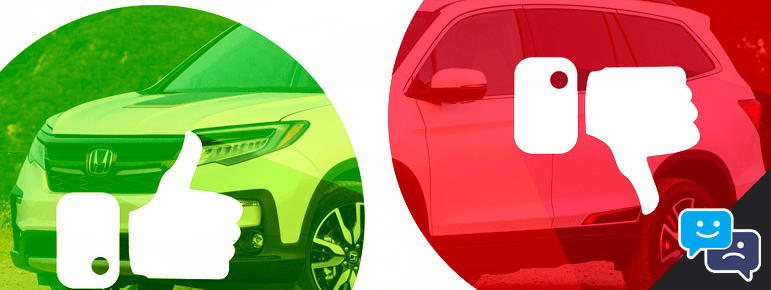The Honda Pilot has been in production for a while, and its reputation has been fairly mixed. Some good, some bad. And, it’s fair to say that if you don’t do your research, you may end up with a unreliable SUV. So, which Honda Pilot years to avoid, and why?
The 2003 Honda Pilot is the least reliable with transmission issues like gear shifting problems, slipping, jerking, and early failure. Other problematic years are 2005, 2009, 2011, 2013, 2016, 2017, and 2019. Recent models from 2018 onwards have been mostly trouble-free.
Are you in the market for a used Honda Pilot? Chances are, you’ve already written down your wish list of desirable features. Features such as Bluetooth connectivity, third-row seating, and maybe even a panoramic sunroof.
But is there anything else you should consider when it comes to finding the perfect vehicle for you and your family? Absolutely!
Vehicle reliability is critical, as purchasing a defect vehicle could easily put you and your family in danger, or financially devastated.
And truth is, Honda has a strong reputation of manufacturing reliable products. But, with a long line of automobiles, Honda has put out some duds over the years.
In this guide, we’ll look at which Honda Pilot years should be avoided when shopping for a used vehicle.
Why Avoid 2003-2004 Honda Pilot Models?
The Honda Pilot’s initial generation marked its entry into the highly competitive midsize SUV market. While it offered a roomy interior, comfortable seating, and a capable V6 engine, this generation had a few drawbacks.
Some of the major concerns reported by owners were related to transmission problems, specifically with the 2003 and 2004 models.
Issues such as transmission failure, slipping gears, and faulty torque converters plagued these early years, causing significant inconvenience and costly repairs for many owners.
In fact, the cost to rebuild a transmission for a 2003-2004 Honda Pilot can range from $1,500 to $3,500.
It’s advisable to steer clear of the first-generation Pilot models, particularly those manufactured in 2003 and 2004.
Why Avoid 2009-2011 Honda Pilot Models?
The second generation of the Honda Pilot addressed many of the issues from its predecessor and introduced several improvements, making it a popular choice among buyers.
However, there are a few model years that should be approached with caution.
For example, the 2009 Honda Pilot saw reports of excessive oil consumption, particularly in the V6 engine.
Additionally, some owners experienced engine misfires and the need for frequent oil top-ups, which could be indicative of more significant issues down the line.
Another year to be cautious of is 2011. While it generally offered a solid performance, the 2011 Honda Pilot experienced problems with its automatic transmission.
Owners reported the 5-speed transmission as rough shifting, had excessive vibration and slipping gears. Honda recommended a transmission fluid change was the recommended service to remedy the issue.
Unfortunately, most owners found these problems to intermittently continue to occur.
To make matters worst for the 2011 models, some batches are known to have torque converter issues.
Why Avoid 2016-2021 Honda Pilot Models?
The third-generation Honda Pilot showcased notable improvements, including a sleeker design, advanced safety features, and enhanced fuel efficiency. However, a specific model year stands out as one to avoid.
And that model year is the 2016.
Truth is, the 2016 Honda Pilot suffered from an infotainment system that drew significant criticism from owners.
The system was reported to be slow, unresponsive, and prone to freezing, making it a frustrating experience for tech-savvy drivers.
To make matters worst, the 2016 model had a higher-than-average number of complaints related to unintended acceleration problems.
Some owners also reported issues with the engine idle stop system, with the vehicle turning off completely in the middle of traffic at a traffic light.
The 2017 Honda Pilot also had similar issues as the 2016 model year. However, owners have reported that the biggest issue is engine related. More specifically, problems with the vehicle’s engine idle start/stop system.
In fact, the auto idle stop problem is so widespread that a class action lawsuit over the issue has been filed. If you have your heart set on a 2016-2017 Honda Pilot – please proceed with caution.
The 2008 Honda Pilot is the Top Pick Among Early Model Years
If you are shopping for a second car, or on a budget and not in a place to buy new then the 2008 Honda Pilot is an excellent choice.
In fact, the only serious issue to be aware of was an aigbag recall. If you find a clean 2008 Honda Pilot, and considering purchasing it, make sure these recalls were performed.

From 2018 to Now: Is the Honda Pilot a Smart Investment?
While the jury is still out on the 2022 and 2023 Honda Pilots, what we can report is the 2018 and 2021 Honda Pilot is a smart investment.
The seven year model trend shows us that between the 2017 and 2023 model years, owner complaints were much less for these two Honda Pilot years.
Additionally, the 2018 and 2021 Pilot models also received an overall safety rating of five stars. This indicates that the Pilot has maintained a high level of safety in the years following the 2018 model.
Of course, the 2018 and 2021 Honda Pilots aren’t without their warts. Some owners reported issues with the engine idle start/stop, and forward collision system problems.
But as of this writing, these were only small percentage of complaints. Moral of the story – do your research!
How We Sourced Our Data
This guide was concluded from trustworthy sources such as NHTSA, Edmund, Jd Power, Kelley Blue Book reviews, and the MyCarVoice Vehicle Reliability Reports.
Honda Pilot Years To Avoid FAQs
What is The Seating Capacity of The Honda Pilot?
The Honda Pilot can seat up to eight passengers.
Is the Honda Pilot Available in Different Trims?
Yes, the Honda Pilot is available in various trims, including LX, EX, EX-L, Touring, and Elite.
What is The Engine Size of The Honda Pilot?
The Honda Pilot is equipped with a 3.5-liter V6 engine.
Does the Honda Pilot Have All-Wheel Drive Capability?
Yes, the Honda Pilot offers the option for all-wheel drive on most trims.
What is the Maximum Towing Capacity of The Honda Pilot?
When properly equipped, the Honda Pilot can tow up to 5,000 pounds.
Does the Honda Pilot Have Advanced Safety Features?
Yes, the Honda Pilot is equipped with Honda Sensing® suite of safety and driver-assistive technologies.
How many USB ports does the Honda Pilot have?
The Honda Pilot typically offers multiple USB ports for charging and connectivity.
What is the fuel economy of the Honda Pilot?
The fuel economy varies based on the model and drivetrain, but the Honda Pilot generally achieves competitive fuel efficiency for its class.
Does The Honda Pilot Have Apple CarPlay and Android Auto Compatibility?
Yes, the Honda Pilot usually supports both Apple CarPlay and Android Auto integration.
Does The Honda Pilot Have a Sunroof?
Many trims of the Honda Pilot offer a power moonroof or panoramic roof.
Is There a Hybrid Version of The Honda Pilot Available?
Honda is reportedly gearing up to unveil a hybrid variant of the Pilot model in 2024.
Does the Honda Pilot Have a Third-Row Seating Option?
Yes, the Honda Pilot comes standard with a third-row seating configuration.
What is The Cargo Capacity of The Honda Pilot?
The Honda Pilot typically offers generous cargo space, with the ability to fold down the rear seats for additional room.
Does the Honda Pilot Have a Built-in Navigation System?
Yes, many trims of the Honda Pilot are equipped with a built-in navigation system.
Are There Any Available Entertainment Options For Rear-Seat Passengers?
Some trims of the Honda Pilot offer rear-seat entertainment systems with screens and wireless headphones.
Does The Honda Pilot Have a Hands-Free Power Liftgate?
Certain trims of the Honda Pilot may come equipped with a hands-free power liftgate for convenience.
What is The Warranty Coverage For The Honda Pilot?
The warranty coverage for the Honda Pilot typically includes a limited warranty, powertrain warranty, and corrosion warranty. It’s best to check with a Honda dealership for specific details.
Can the Honda Pilot Accommodate Child Car Seats?
Yes, the Honda Pilot has ample space for child car seats, and it offers multiple LATCH anchors for securing them.
Does the Honda Pilot Have Available Wi-Fi Connectivity?
Some trims of the Honda Pilot may offer Wi-Fi connectivity as an optional feature.
Is the Honda Pilot Suitable For Off-Road Driving?
While the Honda Pilot has decent ground clearance, it is primarily designed for on-road driving.
Does the Honda Pilot Have a Rearview Camera?
Yes, the Honda Pilot is typically equipped with a rearview camera to assist with parking and maneuvering.
Can the Honda Pilot Accommodate a Roof Rack For Additional Cargo Space?
Yes, the Honda Pilot offers the option to install a roof rack for carrying extra luggage or equipment.
Final Thoughts
The Honda Pilot had a rough launch and is still met with mixed reviews today. The models mentioned all tend to be more susceptible to problems that may be costly or down right dangerous.
Be especially careful of the 2003 Honda Pilot when bought used since that model is associated with transmission failure.
However, the 2018 Honda Pilot and its newer counterparts have seen notable improvements in features, reliability, and fuel efficiency.
Honda’s commitment to continuous improvement is evident in the refined components and optimized performance, resulting in increased reliability and customer satisfaction.
Moreover, the vehicles prioritize fuel efficiency through fuel-saving technologies like direct injection and cylinder deactivation, reducing environmental impact.
To be sure to find the safest and most reliable Honda Pilot, use the MyCarVoice vehicle reliability report tool. Running a quick reliability preview is free, but for only $2.99 unlocks the full report. A small cost to help find a smart vehicle purchase!

Managing Editor
Christopher is an automotive technical writer. When he’s not at the local autocross event, he can often be found working on one of his cars. Specializes in automotive class action law, industry trends, and automotive maintenance. Email me direct, or learn more about us

